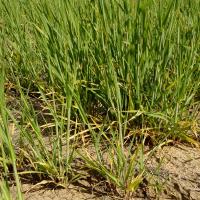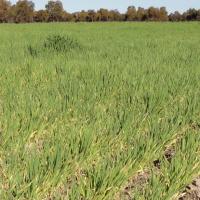Diagnosing nitrogen deficiency in barley
Nitrogen deficiency is the most common nutrient deficiency in barley especially during cold, wet conditions and in sandy soils in high rainfall areas.
What to look for
- Smaller paler plants, generally on sandier parts of the paddock.
- Double sown areas have less symptoms if nitrogen fertiliser was applied at seeding.
- Symptoms may be worse on unburnt non-legume header or swathe rows.
Paddock
- Plants are pale and stunted with thin spindly stems.
- Older leaves are affected first and most severely.
- Affected leaves are noticeably paler than other leaves and start to yellow from tip down eventually turning almost white.
- Leaves then die from the ends and edges, but death may not occur for some time.
- Stems may be pale pink or develop red stripes.
- Less tillers and fewer smaller heads with low protein grain.
Plant
What else could it be
| Condition | Similarities | Differences |
|---|---|---|
| Diagnosing waterlogging in cereals | Pale plants with oldest leaves most affected. | Differences include root browning or lack of feeder roots and wet soil. |
| Diagnosing potassium deficiency in barley | Pale plants with oldest leaves most affected. | Nitrogen deficient plants have more marked leaf tip death and contrast between yellow and green sections of affected leaves. Tillering is also less affected. |
| Diagnosing molybdenum deficiency in cereals | Pale poorly tillered plants. | Difference is that Molybdenum deficiency affects the middle leaves first and cause white heads, shrivelled grain and delayed maturity. |
Where does it occur?

Wet conditions
- Nitrogen deficiency can occur on most West Australian soils but is most common in the following situations:
- In cold, wet conditions that slow nitrogen mineralisation and uptake of nitrogen.
- Soils with very low organic matter.
- High rainfall on sandy soils can result in nitrogen leaching.
Management strategies

Spraying foliar

Soil application

- Nitrogen fertiliser or foliar spray.
- There is a risk of volatilisation loss from urea or nitrate sources of nitrogen. Loss is greatest from dry alkaline soils with dewy conditions, but rarely exceeds 3% per day.
How can it be monitored?

Tissue test
- Use whole top-of-plant test to diagnose suspected deficiency.
- Nitrogen soil testing by itself is of little value for most soils.
- Models that combine 0 -10 centimetres soil organic carbon, soil type and legume history are valuable for nitrogen fertiliser calculation.
Where to go for expert help
Page last updated: Monday, 27 February 2017 - 12:33pm





